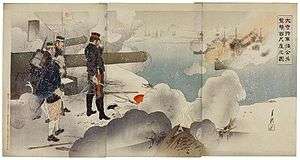Ōdera Yasuzumi
| Ōdera Yasuzumi | |
|---|---|
|
Major General Ōdera | |
| Native name | 大寺安純 |
| Born |
March 9, 1846 Satsuma Domain, Japan |
| Died |
February 9, 1895 (aged 48) Weihai, Shandong Province, China |
| Allegiance | Empire of Japan |
| Service/branch | Imperial Japanese Army |
| Years of service | 1871- 1895 |
| Rank | Major General |
| Battles/wars | |

Ōdera Yasuzumi (大寺安純, 9 March 1846 – 9 February 1895) was a general in the early Imperial Japanese Army, and the highest ranking casualty on the Japanese side in the First Sino-Japanese War.
Life and career
Ōdera was born in Satsuma Domain (present day Kagoshima Prefecture), as the second son of a samurai in the service of the Shimazu clan. He studied at the domain’s military academy, and fought in the Boshin War of the Meiji restoration. In 1872, he entered the fledgling Imperial Japanese Army as a second lieutenant. He was soon promoted to lieutenant, and in February 1874, Ōdera participated in the suppression of the Saga Rebellion, followed by the Taiwan Expedition of 1874. He later served in the Hiroshima Military District, the IJA 12th Infantry Regiment, During the Satsuma Rebellion, he was a company (military unit) commander. Ōdera subsequently served with the IJA 11th Infantry Regiment, as a brigade commander in IJA 8th Infantry Regiment, and as a brigade commander in the Imperial Guards. He was promoted to captain in 1888, after which he served as chief of staff of the IJA 2nd Division, IJA 4th Division and IJA 1st Divisions and was sent to Europe as a military attaché. In November 1894, Ōdera was promoted to major general and made commander of the IJA 11th Infantry Regiment. While leading his troops during the Battle of Weihaiwei in the First Sino-Japanese War against the land fortifications guarding the naval base, his position was hit by an artillery shell fired by the Beiyang Army defenders. Ōdera was the only Japanese general killed in combat during the war.
Ōdera was posthumously promoted to 3rd Court rank, and his son was ennobled with the title of baron (danshaku) under the kazoku peerage system. Ōdera’s grave is at Aoyama Cemetery in Tokyo, and some of his personal effects are on display at the Yūshūkan Museum associated with Yasukuni Shrine in Tokyo.